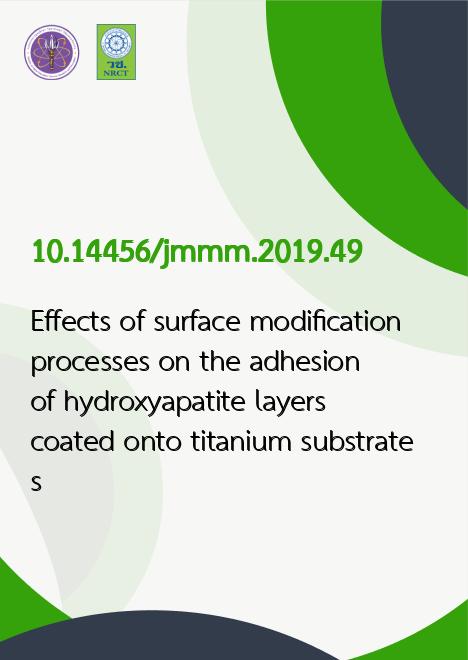
|
Effects of surface modification processes on the adhesion of hydroxyapatite layers coated onto titanium substrates |
|---|---|
| รหัสดีโอไอ | |
| Creator | Oratai JONGPRATEEP |
| Title | Effects of surface modification processes on the adhesion of hydroxyapatite layers coated onto titanium substrates |
| Contributor | Benjaporn INSEEMEESAK, Ratchatee TECHAPIESANCHAROENKIJ, Ampika BANSIDDHI, Monchanok VIJARNSORN |
| Publisher | Metallurgy and Materials Science Research Institute Chulalongkorn University |
| Publication Year | 2562 |
| Journal Title | Journal of Metals Materials and Minerals |
| Journal Vol. | 29 |
| Journal No. | 4 |
| Page no. | 69-79 |
| Keyword | Titanium, Adhesion, Hydroxyapatite, Solution combustion, Internal fixation |
| URL Website | http://ojs.materialsconnex.com/index.php/jmmm/article/view/489 |
| Website title | Effects of surface modification processes on the adhesion of hydroxyapatite layers coated onto titanium substrates | Jongprateep | Journal of Metals, Materials and Minerals |
| ISSN | 8576149 |
| Abstract | Hydroxyapatite (HA, Ca10(PO4)6(OH)2) is a biomaterial exploited in bone graft and implant coating applications. The present study aimed at developing the technique employed in coating hydroxyapatite onto internal fixation titanium plates. The coating consisted of hydroxyapatite layer and titanium dioxide layer, functioning as a buffer layer between hydroxyapatite and titanium plate substrate. The titanium substrates were i) untreated; ii) polished and immersed in 70% nitric acid; and iii) immersed in nitric acid. Coating of titanium dioxide and hydroxyapatite layers were achieved via hydrothermal technique. Porous hydroxyapatite layers with the average pore size close to 120 ?m, and porosity ranging from 40 to 45% were observed. Fair adhesion among titanium substrate, titanium dioxide and hydroxyapatite layers were found in the samples prepared by polishing and acid immersion and the ones prepared by acid immersion. A peeling method (ASTM D3359 09E2), used in evaluation of adhesion on a 0B to 5B scale, was employed in determination of adhesion strength of the coating. The peeling results revealed that complete detachment of the buffer and hydroxyapatite layers occurred in untreated substrates. For the polished and acid immersed samples, the 2B category adhesion, which corresponds to film removal between 15 to 35%, was observed. The observation was being agreed with the image analysis which indicated that 67.7%-69% of coated area remained. Potential biocompatibility was tested by simulated body fluid (SBF) immersion. After 28 days, pH values remained unchanged. Slight weight increase and hydroxyapatite formation after immersion was observed, indicating potential bioactivity of the samples. |
